Naval flags. List of flags of the Armed Forces of Russia
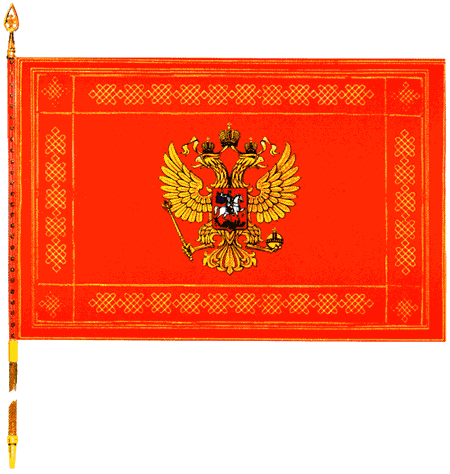
Regulations on the flags of the troops and military formations of the Armed Forces of the Russian Federation - approved by order of the Ministry of Defense of the Russian Federation No. 399 of November 14, 2003:
“Flags of troops and military formations of the Armed Forces of the Russian Federation (hereinafter referred to as flags of troops, types and types of troops) are official symbols denoting the belonging of military control bodies, formation, military units, organizations of the Armed Forces of the Russian Federation to the troops and military formations of the Armed Forces of the Russian Federation.
Flags of the troops - military symbolism serve as a reminder to servicemen of the sacred duty to protect the Fatherland and symbolize the military prowess, honor and glory of the Armed Forces of the Russian Federation, the idea of military fraternity and the cohesion of the military collective.
Flags of troops are placed (installed, hung out):
- constantly - in the offices of the relevant commanders (chiefs);
- in the days of military glory (victorious days) of Russia, state holidays of the Russian Federation - on the buildings of the headquarters (offices) of the troops and military formations of the RF Armed Forces, on the buildings at the entrance to the territory of military units (organizations of the RF Armed Forces), troops and military formations of the Armed Forces of the Russian Federation .
With the simultaneous deployment of the State Flag of the Russian Federation and the flag of the troops (military symbols), the latter is located on the right side of the State Flag of the Russian Federation, if you face them.
At the same time placing the flag of the Ministry of Defense and the flag of the troops, the latter is located on the right side of the flag of the Ministry of Defense, if you face them.
With the simultaneous deployment of the State Flag of the Russian Federation, the flag of the Ministry of Defense and the flag of the troops, the latter is located on the right side of the State Flag of the Russian Federation, if facing them.
With the simultaneous deployment of the flag of the troops ( military symbolism) and other flags (standards), except for the State flag of the Russian Federation and moisture of the Ministry of Defense, with an odd number of troops flag located in the center, while other flags (standards) can not be placed above the flag of the troops, and their size exceeds the size of the flag of troops .
In the days of mourning at the top of the flagpole, a black ribbon is fastened, the length of which is equal to the length of its cloth. The flags of the troops, raised on the mast (flagpole), will descend to half of the mast (flagpole) ... "
| Flag of the Ministry of Defense of the Russian Federation | |
|---|---|
| Ministry of Defense flag, military symbolismwhich is a rectangular double-sided cloth. The design of the front and back sides of the cloth is the same and consists of a four-pointed white cross with flared ends and with equally divided red-blue corners (between the ends of the cross). In the center of the cloth is a military heraldic badge - the emblem of the Ministry of Defense of the Russian Federation. The ratio of the width of the flag to its length is 2: 3. The ratio of the width of the emblem to the length of the flag 1: 2 | |
| Presidential Decree of July 21, 2003. Number 821 "On the Military Heraldic Badge - emblem and flag of the Ministry of Defense of the Russian Federation" | |
| Flag of the Land Force | |
| Flag of the Army - military symbolism, is a double-sided red cloth. In the center of the cloth - the image of a small emblem of the Ground Forces (golden flaming gerenada against the background of two crossed swords). The ratio of the flag's width to its length is 2: 3. The ratio of the width of the emblem of the army to the length of the flag is 4: 5. | |
| Order of the Minister of Defense of the Russian Federation of May 27, 2004 № 150 "On the flag of the Ground Forces" | |
| Flag of the Air Force (Air Force) | |
| Air Force flag is military symbolism in the form of a rectangular double-sided cloth of blue color. In the center of the cloth - the image of crossed silver propeller and anti-aircraft cannon on the silver soaring wings. 14 expanding yellow rays diverge from the center of the cloth to the corners and edges, each of which is 1/2 its width at the edges of the flag. Four beams are directed to the corners of the cloth, two - to the middle of the upper and lower edges of the cloth, and the rest are evenly distributed between them. The ratio of the width of the flag to its length - 2: 3. The ratio of the width of the wingspan to the length of the flag is 1: 2. | |
| Order of the Minister of Defense of the Russian Federation of May 26, 2004 №160 "On the flag of the Air Force" | |
| Flag of the Navy (Naval (Andreevsky) flag of the Russian Federation) | |
| Naval flag is military symbolism in the form of a white cloth with two diagonal stripes of blue. Flag sizes: the ratio of the width of the flag to its length is 1: 1.5; The width of the blue bar is 1/10 of the flag. | |
| Decree of the President of the Russian Federation of July 21, 1992. No. 798 "On the naval flags and pennants of the Russian Federation" | |
| Flag Airborne (Airborne Forces) | |
| Flag of the Airborne Forces - military symbolism representing a rectangular blue cloth with a green stripe at the bottom. In the center of the cloth there is an image of a golden parachutist and two planes on both sides of the parachute (hereinafter the image is called). The ratio of the width of the flag to its length is 2: 3. The ratio of image width to flag length and image height to flag width is 1: 2. The ratio of the width of the green strip to the width of the flag is 1: 4. | |
| Order of the Minister of Defense of the Russian Federation of May 30, 2004 №125 "On the flag of the Airborne Forces" | |
| Space Forces Flag | |
| The Space Forces Flag is a two-sided blue cloth. In the center of the cloth is a small emblem of the Space Forces (a stylized contour image of a silver launching space rocket against the background of a stylized globe). The rocket is depicted as a vertical acute triangle. The image of the globe is divided by four horizontal stripes6 the first from the top is dark blue, the second is white, the third is blue, the fourth is red. At the top of the ellipse are two symmetrical triangular segments. At the bottom of the image of the rocket - a quadrilateral red color with an inner bottom angle. The ratio of the width of the flag to its length is 2: 3. The ratio of the width of the emblem to the length of the flag is 1: 2. | |
| Order of the Minister of Defense of the Russian Federation dated June 14, 2004 №180 "About the flag of the Space Forces" | |
| Flag of the Strategic Missile Forces (Strategic Missile Forces) | |
| The Strategic Missile Forces Flag is military symbolism representing a double-sided cloth of dark blue color with a red stripe in the lower part. In the center of the cloth is the image of a golden round shield and sword on crossed gold arrows (hereinafter referred to as the image). Shield with an ornament and a rim with eight rivets. The ratio of the width of the flag in its length is 2: 3. The ratio of image height to flag width is 1: 2. The ratio of the diameter of the shield and the width of the red strip to the width of the flag is 1: 4. | |
| Order of the Minister of Defense of the Russian Federation dated June 14, 2004 №170 "On the flag of the Strategic Missile Forces" | |
- A flag is a piece of fabric with a distinctive design that is used as a symbol, as a signaling device, or a decoration. National flags are variously used for design, including flags, flags, flags, flag patterns, and others. It is also used to make a statement about the name of some military units. A flag is the equivalent of a field in the United States of America, where it can be categorized as vexilloid or flag-like. It was used as a device for battle. Already during the medieval period, and during the Late Middle Ages. The International Maritime signal flags have been flagged for individual units during the Early Modern period. It is a national or international flag. Some of the examples include the flag of Denmark, the Dannebrog in 1478, the oldest tricolour. It is the time when it comes to the colors of the red. During the 15th century, it was taken for the third quarter of the 16th century. doubled. It’s been a red flag –––––––––––– century. During the World War II, it was added that it would be the case when it came to the three colors. It comes from orange-blue, it’s not a bit more orange than the orange-blue above the red-white-blue. It was said that it was the flag of the French national flag of France. , Italy, Costa Rica, Dominican Republic, Ireland, Haiti, Romania and Mexico. It is the flag of the United Kingdom of the United Kingdom of the United Kingdom.
2. The Armed Forces of the Russian Federation, established after the dissolution of the Soviet Union. The Armed Forces were formed in 1992. The Commander-in-Chief of the Armed Forces were formed in 1992. It is a number of 2,929,629 units, including 1,134,800 units, was set. In 2010, the International Institute for Strategic Studies of the Armed Forces numbered about 1,027,000 active troops. It was a 93 per cent of the required manpower. According to SIPRI, Russia spent $ 66.4 billion on arms in 2015, between the years 2005–2009 and 2010–2014, Russian exports of major weapons increased by 37 percent according to SIPRI. It was raised to 30. According to the Russian Defense Ministry, it was raised to 30. 5–70. 7% as of July 2015, he was officially disbanded over the first half of 2016. to transform the Commonwealth of Independent States failed. Until 1995, it was estimated that they would be deployed in 10 regions, including cities and cities. It was about the 15th year of the United States of America. On 14 February 1992 Shaposhnikov formally became the Supreme Commander of the Commonwealth of Armed Forces, finally, on 7 May 1992. In May 1992, by the end of 1993, Colonel Pavel Grachev became the Minister of Defense. In the next few years, the Russian Forces have been identified. A new military doctrine, promulgated in November 1993, implicitly acknowledged the contraction of the old Soviet military. It was not necessary, but it’s not necessary to make it more difficult to achieve. He added that he would not be able to make any changes.
3. The special service - gathering of information, communication interception, cooperation, interception, public relations, Analysis or intelligence assessment. Intelligence agencies can provide services for their national governments. There is a distinction between domestic threats. Foreign Intelligence Agency, The Flags of the CIA, JCS, and NSC, Stanford, Calif. Narizi z Іstorії rozvіdki subєktіv holding in the Terens of Ukraine / Zag, journals Journal of Intelligence History Reports Ruiz, Victor H.2010. A Basic Knowledge of Military Taxonomy
4. Southern Military District (Russia) - The Southern Military District is one of the four operational strategic commands. The district was formed in accordance with the Presidential Decree No. 1144 signed on September 20,2010, the District of the Fleet and the Caspian Flotilla. The Southern Military District was formed on October 22,2010, by order of then Russian Defense Minister Anatoly Serdyukov, on July 22,2010, interim commanders were named for the new military districts. Galkin was later promoted to the Southern Military District. On September 20, 2016, Colonel general Aleksandr Dvornikov became the commander of the district, in 2016. The 49th Army reunderstand it with its headquarters. There are also three airplanes and air defense forces. Black Sea Fleet and Caspian Flotilla, including their respective air. In early 2017, the war of the 8th Guards Army is located at the 150th Motor Rifle Brigade. June 2017
5. Central Military District (Russia) - The Central Military District is one of the Russian Military Districts. Was formed in Presidential Decree # 1144 signed on September 20,2010, the Siberian Military District. Until 2010, Colonel General Vladimir Chirkin was the commander with Lieutenant General Sergei Surovikin. From the next year, he was commanded by the policeman for 2014. During his visit to the military district, Vladimir Zarudnitsky took command. It was reported that it had been formed in November 2015. It was the Berlin Red Banner which was 588th Separate Motor Rifle Regiment. August 2008, South Ossetia. 21st Guards Motor Rifle Brigade 3rd Guards Spetsnaz Brigade 24th Spetsnaz 473rd District Training Center 31st Guards Airborne Brigade 14th Air Brigade
6. Eastern Military District - The Eastern Military District is one of the four operational strategic commands. The district was formed in the Presidential Decree No. 1144 signed on September 20,2010 and absorbed at Khabarovsk. Colonel General Sergey Surovikhn has been demanding the list since October 2013, C3 Brigade is synonymous with headquarters brigade
7. The Russian naval flag is a white background with two blue diagonal bands, forming a saltire, called St Andrews Cross. The ratio is 1 /1.5. In 1698, he was awarded the order for military exploits and public service. It is a rule that it has been established that it will be the first time that it became a rule. From 1692 to 1712, it was consistently taken by the Navy. After the Russian revolution, the Russian Navy Ensign was changed. The flag of St. Andrew was reintroduced in 1992. The flag of the navy in the navy in 1992
8. Communication Troops - Russian Signal Troops. Signal Troops. It is a rule of thumb and it is the timeliness of the combat equipment. The human race has experienced great success. The communication nodes were given 55 communication nodes. Already in March 1905, these officers were raised as a separate armor. This Corps consists of two divisions, one telegraphs and one hundred cable lines. The Corps fought bravely
9. Central Army Sports Club - CSKA Moscow is a major Russian sports club based in Moscow. The CSKA had to be a team of sportsmen, the CSKA Moscow. For the football club, see PFC CSKA Moscow, for the futsal club, see MFK CSKA Moscow. For the ice hockey club, see HC CSKA Moscow, for the volleyball club, see VC CSKA Moscow. For the mens club, see PBC CSKA Moscow. For the womens club, see WBC CSKA Moscow. For the water sport club wrestling club, VC CSKA and WBC CSKA were disbanded in 2009. The CSKA has also been the elite skaters, including Adelina Sotnikova, Ekaterina Gordeeva. Elena Mukhina, the 1978 World Champion artistic gymnast, was a member, the field was located at the Sokolniki Park in Moscow. On April 29, 1923, he wondered what was going on. In October 1953, it was renamed into the Central Sports Club of the United States Military District. - May 31,1937 Komkor Fyodor Rodionov
It turns out that BANNER and FLAG are completely different concepts!
Banner - this is the cloth on which emblems or inscriptions are drawn, printed or embroidered. It is attached directly to the pole. Each banner is unique: it is created only in a single copy!
Flags on the contrary, a mass product. They are produced in large quantities, so that if necessary they can be replaced with exactly the same ones, or so that the same flags can be used by different organizations. For example, if the flag of the Ministry of Education of Russia existed, then each state school of our country would have such a flag, it would show that the school belongs to this Ministry.
Flags are attached to the pole and to the cord - in this case they can be raised on flagpoles.
The Russian army has one most important thing. banner - Banner of the Armed Forces of the Russian Federation, which is stored in the General Staff of the Armed Forces of the Russian Federation.
And each of the three types of the Russian army has its own banners, which are stored, respectively, in the General Staff of the Land Force, the General Staff of the Air Force and the General Staff of the Navy.


Banner Ground Forces.

![]()
Banner of the Air Force.
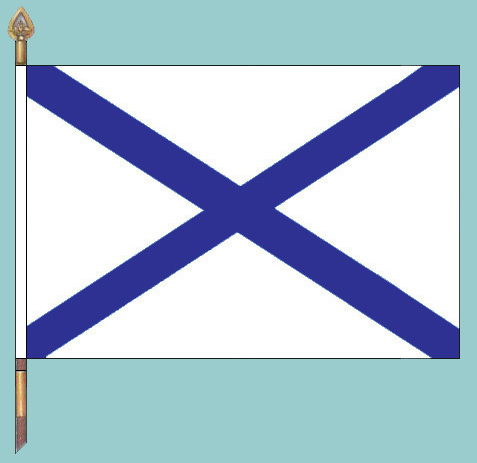
Banner of the Navy of the Russian Federation (the same on both sides).
But flags of troops the Russian army has a lot - becausein our army there are all modern types of troops! Each flag is a rectangular double-sided cloth, that is, the images on both sides are the same.
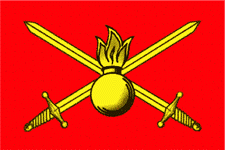
|
Flag of the Ground Forces. In the center of the cloth - the image of a small emblem of the Ground Forces (golden flaming gerenada against the background of two crossed swords). |

|
Flag of the Air Force. In the center of the cloth - the image of crossed silver propeller and anti-aircraft cannon on silver soaring wings. |

|
The naval flag is a white cloth with two diagonal stripes of blue. |

|
Flag of the Strategic Missile Forces. In the center of the cloth there is an image of a golden round shield and sword on crossed golden arrows. Shield with an ornament and a rim with eight rivets. |
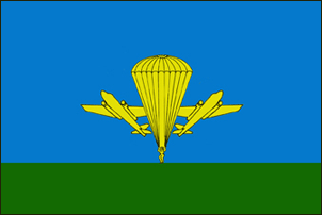
|
Flag of the Airborne Forces. In the center of the cloth is an image of a golden parachute with a figure of a parachutist and two planes on both sides of the parachute. |
| |
Flag of the Space Forces. In the center of the cloth is a small emblem of the Space Forces (a stylized contour image of a silver launching space rocket against the background of a stylized globe. The rocket is depicted as a vertical acute-angled triangle. The image of the globe is divided by four horizontal stripes: the first is dark blue, symbolizing the sky, the rest three lanes symbolize Russia. |
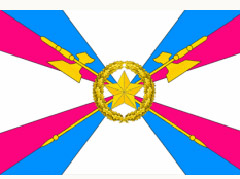
|
Flag of the rear of the Armed Forces of the Russian Federation. In the center of the cloth there is an image of a golden five-pointed star in a golden oak wreath on gold halberds crossed diagonally. |

|
Flag of troops of radiation, chemical and biological protection. In the center of the cloth there is an image of a regular contour golden hexagon, in the black field of which there are three diverging golden rays with four intersected red rings in the lower part, on a silver diagonally crossed flaming arrow and a smoke plume. |
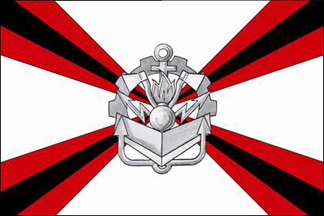
|
Flag of engineering troops. In the center of the cloth there is an image of a silver blade of a tracker, anchor, flaming grenada with lightning and crossed axes framed on top by a gear wheel. |
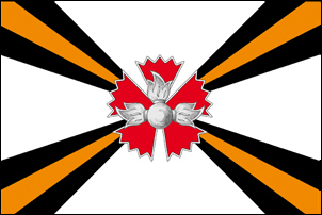
|
Flag reconnaissance units and military units. In the center of the cloth there is an image of silver three-flame grenada on the background of a red carnation flower, the petals of which have five teeth each, framed by a silver edging. |
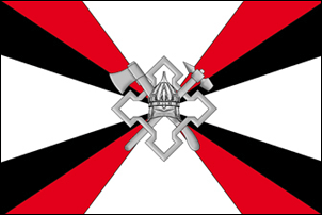
|
Flag of military units and organizations quartering and arrangement of troops. In the center of the cloth there is an image of a silver pointed helmet in the center of a four-bastion fortetia with a hammer and ax crossed. |
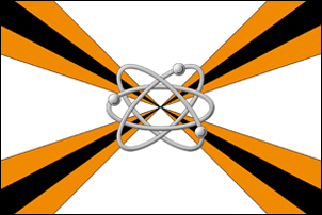
|
Flag connections and military units of nuclear security. In the center of the cloth - the image of three silver intersecting stylized electron orbits with electrons. |
The Minister of Defense, in turn, presented the personal standard to Colonel General A.D. Kosovan, the head of the construction and quartering of troops, the Deputy Minister of Defense of the Russian Federation. The nominal brace on the standard was established by the honorary chairman of the Council of veterans of the VSK Defense Ministry of the Russian Federation, Marshal of the Engineering Troops NF Shestopalov.
Shtandart is a square white plate. The corners of the cloth are painted in red and blue. In the center of the wreath is the emblem of the service of building and quartering the troops (two-headed eagle, the silhouette of the bastion) against a dark background.
In December 1999, Minister of Defense Igor Sergeyev presented the Chief of Logistics of the Armed Forces Vladimir Isakov with the Standard of the Chief of Logistics of the Armed Forces - Deputy Minister of Defense of the Russian Federation (the standard was approved by order of the Minister of Defense).
On January 21, 2000, at the headquarters of the Air Force, Minister of Defense I.Sergeyev handed the commander-in-chief of the Air Force to Anatoly Kornukov a personal standard. The standard is made according to the motives of the Air Force flag - blue and yellow rays emanate from the center of the cloth, and the Air Force emblem is in the center of the blue field surrounded by a wreath.
In July 2000, the Heraldic Council under the President of the Russian Federation drafted and approved a draft decree on the St. George banner for specially distinguished units in combat operations.
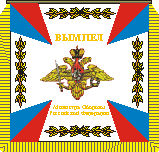

On December 26, 1998, by Order No. 581, the Minister of Defense of the Russian Federation, I.Sergeev, approved the Vimpel of the Minister of Defense of the Russian Federation for courage, military prowess and high combat skills. This pennant is a reward to military teams for the achievements shown in the performance of the tasks of the Minister of Defense of Russia, for the differences in the course of combat training.
The white square pennant square (70x70 cm) with golden fringe and tassels is attached to the horizontal bar by the top edge. The shaft of the pennant is dark brown, the top is golden, in the form of a flat slotted tip of a spear with the image of the State Emblem of Russia. The corners of the cloth are red-blue. The front side shows a military heraldic badge of the Armed Forces of the Russian Federation and the inscription: “VIMPEL of the Minister of Defense”. On the back it says: "For courage, military prowess and high combat skills" and the year of awarding.

"The banner of the Air Force (hereinafter referred to as the banner) consists of a double-sided cloth, a flagpole, pommel, brackets, inflows and znamenny nails. Banner ribbons, cords with tassels, a pantaloire and a banner can also be included with the banner.
The banner is rectangular, blue in color. 14 expanding yellow rays diverge from the center to the edges of the cloth. In this case, four beams are directed into the corners of the cloth, two - toward the middle of the upper and lower edges of the cloth, and the remaining rays are evenly spaced between them. The width of the rays at the edges of the cloth is 1/12 of the width of the cloth.
On the front side of the cloth, in the center, is the main figure of the State Emblem of the Russian Federation: a golden double-headed eagle that has raised its wings open. The eagle is crowned with two small crowns and - above them - with one large crown connected by a ribbon. In the right paw of an eagle - a scepter, in the left - power. On the chest of an eagle, in a red shield, is a silver rider in a blue raincoat on a silver horse, striking with a silver spear of black, overturned on its back and trampled by a dragon.
On the back side of the cloth is the emblem of the Air Force: a golden double-headed eagle with outspread wings, holding a crossed silver propeller and an anti-aircraft gun in its paws. On the chest of the eagle is placed a shield, topped with a golden crown. In a shield, on a red field, is a silver horseman, spearing a dragon.
The width of the emblem and emblem is 80 cm. The width of the cloth is 113 cm, the length is 170 cm, with a margin for fastening to a flagpole made of blue fabric.
The flag shaft is wooden, round, painted in brown. The diameter of the shaft is 4 cm, length - 250 cm.
The banner bracket is in the form of a rectangular plate of golden metal, on which are engraved the words: "MILITARY - AIR FORCES" and the date of presentation of the banner.
The top is metallic, golden, in the form of a slash with a relief image of the State Emblem of the Russian Federation.
The flow is metallic, golden, in the form of a truncated cone 9 cm high. The caps of znamenny nails are golden. "
On February 19, 2002, President Putin ceremonially handed over banners to the branches of the Armed Forces and other law enforcement agencies: ground forces, air force, navy, civil defense forces, FAPSI, internal troops, border troops.
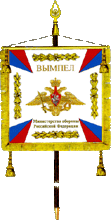
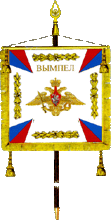

On December 26, 1998, Order No. 581 "On the establishment of the Minister of Defense of the Russian Federation for Vimpel for courage, military prowess and high combat skills" Minister of Defense of the Russian Federation I.Sergeev approved the Pennant for the Minister of Defense of the Russian Federation for courage, military valor and high for military skills. This pennant is a reward to military teams for the achievements shown in the performance of the tasks of the Minister of Defense of Russia, for the differences in the course of combat training. Description of the pennant:
"The pennant consists of a cloth, a pole and a pommel.
The surface of the Pennant is square, white, made of double folded fabric. In the center of the front side of the cloth is a military heraldic badge - the emblem of the Armed Forces of the Russian Federation. Along the edges of the cloth - straight branches of laurel and oak leaves. In the corners of the cloth, blue-red rays are shown, converging towards the center and ending at a distance of 1/3 the length of the cloth from the outer edge. The width of the rays at the outer edge of the cloth is 1/6 of the width of the cloth. The cloth is edged with fringe, the white field of the cloth is framed by edging. Fringe and pip of golden color.
On the front side of the cloth above the emblem is an inscription in capital letters: “VIMPEL”, under a military heraldic sign — the emblem of the Armed Forces of the Russian Federation — inscription in lowercase letters in two lines: “Minister of Defense of the Russian Federation”.
On the back side of the cloth in lower case letters is the abbreviated valid name of the military unit, in capital letters: "FOR MANAGEMENT, MILITARY PROFESSION AND HIGH COMBINED TRAINING" and the year of awarding.
The size of the side of the Pennant cloth (without fringe): in height and width - 70 cm.
Wooden shaft, Pennant, circular, 38 mm in diameter, 2.5 m long, dark brown, loosened, lacquered.
The top of the golden color is a flat slit tip with a relief image inside the State Emblem of the Russian Federation.
The shaft is mounted on a special metal stand with a round base, in the center of which is a cylindrical rod for the shaft. The base diameter is 40 cm, the height of the stand is 30 cm.
The pennant is attached to the tip with the help of a silk twisted cord of golden color connected to a metal rod inserted into the upper part of the Pennant. "
Changes to the order on the pennant of the Minister of Defense were made by the order of the Ministry of Defense of the Russian Federation No. 174 in 2013.
order No. 85 of the Minister of Defense of the Russian Federation dated March 6, 2006 “On the Establishment of the Honorary Rolling Prize of the Ministry of Defense of the Russian Federation for Suvorov Military, Nakhimov Naval, Military Musical Schools and Cadet, Naval Cadet, Music Cadet Corps of the Ministry of Defense of the Russian Federation” Honorary carryover prize of the Ministry of Defense of the Russian Federation "The best school (cadet corps) of the Ministry of Defense of the Russian Federation". Description of the pennant:
"The pennant consists of a cloth, a pole with a stream, pommel, staples, cords with brushes and special nails.
The surface of the Pennant is made of double folded dress fabric, square, white. Along the edges of the cloth - straight branches of laurel and oak leaves. In the corners of the cloth, blue-red rays are shown, converging towards the center and ending at a distance of 1/3 the length of the cloth from the outer edge. The width of the rays at the outer edge of the cloth is 1/4 of the width of the cloth. The cloth is edged with a fringe of golden color.
On the front side of the cloth in the center is the emblem of the Armed Forces of the Russian Federation (hereinafter - the emblem). The width of the emblem is 2/3 of the width of the cloth. Above the emblem - the inscription in capital letters: "VIMPEL", under the emblem - the inscription in lowercase letters in two lines: "The Ministry of Defense of the Russian Federation."
On the back side of the cloth in the center is an inscription in capital letters in five lines: “TO THE BEST SCHOOL (KADETIAN CASE) OF THE MINISTRY OF DEFENSE OF THE RUSSIAN FEDERATION”.
The shaft The pennant is wooden, dark brown, unscrewed, lacquered, 250 cm long, circular in cross section, 4 cm in diameter. The shaft is mounted on a special stand with a round base and fixture to be fixed to the floor. The base diameter is 40 cm, the height of the stand is 25 cm.
On the pole of the Pennant, golden brackets are fastened (height - 5 cm, length - 12.5 cm) with the inscription of the name of the school (cadet corps) and the year of awarding.
The Vimpel's cloth is fastened on a pole at the lower edge of the pommel by means of a golden silk twisted cord connected to a wooden rod. The cords with tassels are attached to the ends of the rod. The cloth is nailed to the rod with round gold-colored hats. "
Order of the Minister of Defense of the Russian Federation of April 21, 2005 No. 140 "On passing Vimpel and Honorary Certificate of the Minister of Defense of the Russian Federation to encourage winners of the competition among the subjects of the Russian Federation to better prepare citizens of the Russian Federation for military service, organizing and conducting military service" Established Challenge Vimpel of the Minister of Defense of the Russian Federation "To the winner of the competition among the subjects of the Russian Federation for the best training of citizens of the Russian Federation for military service, tions and carrying out military service. " Description of the pennant:
"The pennant consists of a cloth, a shaft with a water inflow, staples and pommel.
The surface of the Pennant is made of double folded dress fabric, square, white. Along the edges of the cloth - straight branches of laurel and oak leaves. In the corners of the cloth, blue-red rays are shown, converging towards the center and ending at a distance of 1/3 the length of the cloth from the outer edge. The width of the rays at the outer edge of the cloth is 1/4 of the width of the cloth. The cloth is fringed with fringe, the white field of the cloth is framed by a piping; in the corners of the cloth there are brushes on silk twisted cords. Fringe, piping, tassels and cords are golden in color.
On the front side of the cloth in the center is the emblem of the Armed Forces of the Russian Federation (hereinafter - the emblem). The width of the emblem is 2/3 of the width of the cloth. Above the emblem - the inscription in capital letters: "VIMPEL", under the emblem - the inscription in lowercase letters in two lines: "The Minister of Defense of the Russian Federation."
On the back side of the cloth in the center is an inscription in lower case letters: “To the winner of the competition among the subjects of the Russian Federation for the best training of citizens of the Russian Federation for military service, organization and conduct of military draft”
The size of the side of the cloth (without fringe) in height and width - 90 cm.
Wooden shaft The pennant is wooden, dark brown, unscrewing, lacquered, 250 cm long, round cross-section, 4 cm in diameter. The shaft is installed on a special stand with a round base. The base diameter is 40 cm, the height of the stand is 25 cm.
On the pole of the Vimpel, a golden-colored bracket is fastened (height - 5 cm, length - 12.5 cm) with the inscription of the name of the subject of the Russian Federation and the year of awarding.
The top shafts are made of metal of golden color in the form of a volume stylized emblem. The inflow and connecting tube on the pole is made of golden metal.
The Vimpel's cloth is fastened on a pole at the lower edge of the pommel by means of a golden silk twisted cord connected to a wooden rod. The cloth is nailed to the rod with round gold-colored hats. "
Flag of the Ministry of Defense of the Russian Federation
On July 21, 2003, President V.Putin signed Decree No. 821 “On the Military Heraldic Sign-Emblem and Flag Ministry of Defense of the Russian Federation ". By this decree, official descriptions of the ministry's emblem and flag. The documents on the MO flag entered into force after publication in the Rossiyskaya Gazeta on August 7, 2003, No. 156 (3270). The official description of the flag of the Ministry of Defense of the Russian Federation:
"The flag of the Ministry of Defense of the Russian Federation is a rectangular two-sided cloth. The pattern of the front and back sides of the cloth is the same and represents a four-pointed white cross with flared ends and equally divided red-blue corners (between the ends of the cross). The red half corners are adjacent to the vertical ends of the cross .
In the center of the cloth is a military heraldic badge - the emblem of the Ministry of Defense of the Russian Federation.
The ratio of the width of the flag to its length - two to three. The ratio of the width of the emblem to the length of the flag is one to two.
Description of the mark:
"Silver, crowned double-headed eagle with outstretched wings. In the right paw of an eagle - a sword, in the left - an oak wreath. On the chest of an eagle - a red, triangular, downwardly stretched shield with a stem going back to the crown. In the shield field - a rider striking a spear dragon. "
Message MV Revnivtseva
The statute on the military heraldic emblem and flag of the Ministry of Defense of the Russian Federation was approved by order of the Minister of Defense of the Russian Federation of November 14, 2003 No. 399 "On the approval of the Statute on military heraldic badge - the emblem and flag of the Ministry of Defense of the Russian Federation and the Statute on the flags of the troops and military formations Armed Forces of the Russian Federation ".

 Live journal
Live journal Facebook
Facebook Twitter
Twitter